The
Player Editor can be used to edit just about anything regarding a single player. Although you can't change
absolutely everthing about a player, you can move players to other teams, make them free agents, give or remove injuries, change player ratings, and more:
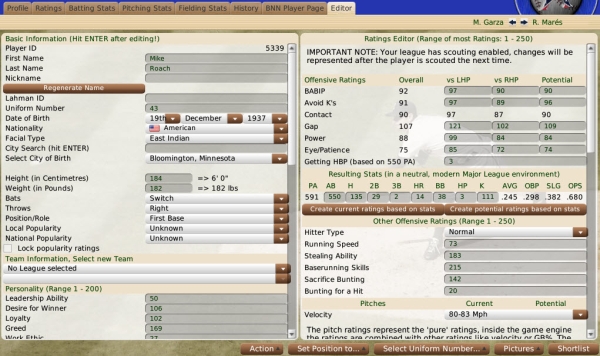
To use the Player Editor, you must be in
Commissioner mode. If you are, the Player Editor will be available as the right-most tab in any
Player Profile:

Changes made in the editor take effect immediately up selecting a value from a drop-down, or when hitting the Enter key in a text field. There is no save button, so be sure to hit the Enter key after making changes!
The Player Editor is split up into many different sections:
Basic and Team Information
The Basic and Team Information sections allow you to edit most of the demographic and core information about a player. Remember to hit Enter after editing any text fields!
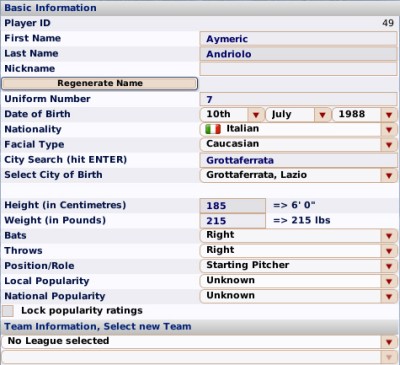
| Option | Description |
| Player ID |
OOTP's unique internal identifier for a player. This isn't shown in-game, but can be valuable to know. For example, if you generate a fictional face for a player, the file will be called "player_#.png," with the # being his player ID. |
| First Name |
Player's first name |
| Last Name |
Player's last name |
| Nickname |
Player's nickname |
| Regenerate Name |
Clicking this button will cause the game to randomly generate a new name for the player. |
| Uniform Number |
Player's uniform number. Has no impact on the game, other than cosmetically. |
| Date of Birth |
Player's birth date. Changing this changes the player's age. This by itself will not change the player's ratings, but it will affect the player. |
| Nationality |
Player's nationality |
| Facial Type |
This is the player's facial type. This is only used for generating fictional faces. If you use photos, or if you like your current player face, do not change this value. Facial Type is not intended to be an accurate representation of the player's actual ethnicity, and so is not displayed on the Player Profile. If you change this, a new picture will be generated for the player immediately. |
| City Search (hit ENTER) |
The City Search allows you to narrow down your player's birth place. Rather than picking from a giant drop-down list, you can type the city name and hit Enter. Then, the Select City of Birth field below will only contain city names matching what you typed. For example, if you want the player to be from Springfield, Massachusetts, you can type in "Springfield," and then hit Enter. The drop-down will now only contain cities named Springfield, and you can choose the correct one. This is not a very powerful search. Only exact matches are found. So, you cannot, for example, type "Spring" and find cities named "Springfield." |
| Select City of Birth |
Select the player's city of birth. This value does impact the game in the area of contract negotiations, as players are often more likely to prefer teams that are closer to home, which in OOTP is defined as the place of birth. |
| Height (in cm) |
Player height. Height has no impact on the game mechanics, but it does factor into body mass, which affects fictional faces. (Players with higher BMI get "fatter" faces.) |
| Weight (in pounds) |
Player weight. Weight has no impact on the game mechanics, but it does factor into body mass, which affects fictional faces. (Players with higher BMI get "fatter" faces.) |
| Bats |
The handedness of the hitter. |
| Throws |
Which hand the player throws with. |
| Position/Role |
The player's assigned position/role. See Player Positions and Roles for more information. |
| Local Popularity |
The player's local popularity rating |
| Nationality Popularity |
The player's national popularity rating |
| Lock Popularity Ratings |
Checking this box prevents the game from changing this player's popularity ratings |
| Select League/Team |
If you wish to assign the player to a team, first select a league from the top drop-down, and then select a team from the bottom drop-down. If the player is already on a team, he will be immediately transferred with his contract intact. If the player is a free agent, he will be given the minimum contract. |
Personality and Morale
The Personality and Morale sections allow you to edit the Personality and Morale ratings for the player. Remember to hit Enter after editing any text fields!
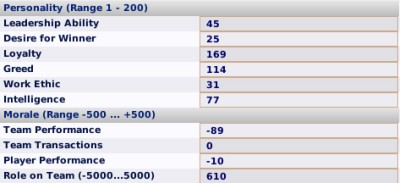 Personality ratings
Personality ratings are on a scale of 1-200, with 200 being the highest ratings. When viewing the Player Profile, these ratings are dynamically converted to whatever ratings scale you are currently using. So, a player with a 200 Intelligence in the Player Editor would have an 80 on the 20-80 scale, a 100 on the 1-100 scale, and so forth. Remember to hit Enter after editing any text fields! See the Personality Ratingsscreenfor more information.
Morale ratings (except for "Role on Team") are on a scale of -500 to 500, with negative numbers indicating unhappiness and positive numbers indicating happiness. So, in the image above, you can see that the player is somewhat unhappy about Team Performance. Role on Team is similar, but is on a scale of -5000 to 5000.
Suspension and Injury Data
The Suspension and Injury Data sections allow you to add, edit, or remove suspensions or injuries from the player. Remember to hit Enter after editing any text fields!
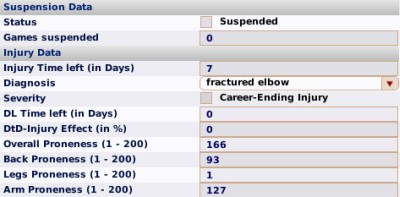
| Option | Description |
| Suspension Status |
Check this box to suspend the player |
| Games suspended |
The number of games for which the player is suspended |
| Injury time left (in days) |
The number of days that the player will remain injured. The severity is defined by the options below. |
| Diagnosis |
The nature of the injury |
| Severity |
Check the Career-Ending Injury box if this injury should be career-ending |
| DL Time left (in Days) |
The number of days remaining in the player's disabled list assignment (if any) |
| DtD-Injury Effect % |
If set to anything other than 0, this makes the injury "day-to-day" and specifies the percentage of effectiveness lost. So, setting this to 30 means the player loses 30% efficiency for the duration of the injury. |
| Overall/Back/Leg/Arm Proneness |
A 1-200 rating for how injury-prone this player is. A higher number means the player is more likely to get injured. |
See the
Suspensions and
Injury and Fatigue pages for more information.
Draft and Roster Status
The Draft List Status and Roster Status Data sections allow you to edit a player's roster status. Remember to hit Enter after editing any text fields!

| Option | Description |
| Unavailable for draft lists |
Used primarily in online leagues, checking this indicates that this player has already been selected in a forum pre-draft, and the player will no longer display on draft lists, reducing the chance of any confusion about who has already been selected. Once the draft is complete, the setting will be removed automatically. See the Draft Listscreenfor more information. |
| Total Major League Service Days |
The number of days of major league service time the player has accumulated. The value will be converted to years based on your league settings for # of days in a service year. |
| Total 40-Man Roster League Service Days |
The number of days of time on a secondary roster the player has accumulated. The value will be converted to years based on your league settings for # of days in a service year. |
| Total pro service years |
The number of years of overall professional service the player has. |
See the
Service Timescreenfor more information.
Salary Data and Contract Extension
The Salary Data and Contract Extension sections allow you to give a player a contract or edit an existing contract. Remember to hit Enter after editing any text fields!

| Option | Description |
| Contract Type |
Check this box to make the contract a major league contract. Otherwise, it is a minor league contract. |
| Contract Length (in years) |
The number of years in the contract. Based on this value, more Salary in Year X boxes will appear below. |
| Current Year of Contract |
Defines in which year of the contract the player currently is. |
| Salary in Year X |
The player's salary for that year of the contract |
| Contract signed in year |
Sets the year in which the contract was signed |
The Contract Extension fields behave in the same fashion. See the
Player Contracts Overview for more information.
Offensive Ratings Editor
The Offensive Ratings section on the top right allows you to set the player's offensive ratings. Remember to hit Enter after editing any text fields! Unless otherwise noted, ratings are on a 1-250 scale, where 1-200 represents the normal range of skill. These values are then converted to whatever rating scale you use in game. For example, a 200 will become an 80 on a 20-80 scale, or a 100 on a 1-100 scale. Ratings of 201-250 are considered "beyond the norm," and will either result in a maximum rating, or a rating of
above the maximum, if you have set the
Show Ratings>Max option to "Yes" in the
Global Setup page. (The default is "No").
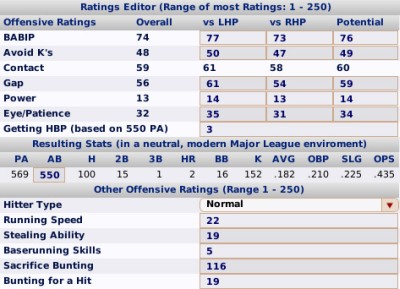
Most of the offensive ratings have slots for versus left-handed pitchers, versus right-handed pitchers, and potential. The standard ratings you see on the Player Profile are an average of the player's ratings against left and right. Most of the offensive ratings are pretty self-explanatory, if you understand the
Baseball Ratings model. The few items in here that need further explanation are below:
| Option | Description |
| BABIP / Avoid K's / Contact |
Hitters are rated for their Contact ability, but this is one rating that cannot be directly edited. Contact is actually calculated based on two other ratings: BABIP ("batting average on balls in play," which not shown in main game screens), and Avoid K's. So, to adjust your player's Contact rating, you must adjust BABIP and Avoid K's. |
| Getting HBP |
How often the player gets hit by pitches, per 550 at-bats. Note that this value is not on a 1-250 scale! |
| Resulting Stats |
This section has no values to change other than the at-bats, but it simply tells you how a player with the ratings you have entered is expected to perform in a neutral, modern Major League environment. So, in the image above, you can see that this player is expected to bat .182 in a Major League environment. Not so great, but it might be fine if you expect him to be a minor league player. |
Pitching Ratings Editor
The Pitching Ratings section on the top right allows you to set the player's pitching ratings. Remember to hit Enter after editing any text fields! Unless otherwise noted, ratings are on a 1-250 scale, where 1-200 represents the normal range of skill. These values are then converted to whatever rating scale you use in game. For example, a 200 will become an 80 on a 20-80 scale, or a 100 on a 1-100 scale. Ratings of 201-250 are considered "beyond the norm," and will either result in a maximum rating, or a rating of
above the maximum, if you have set the
Show Ratings>Max option to "Yes" in the
Global Setup page. (The default is "No").
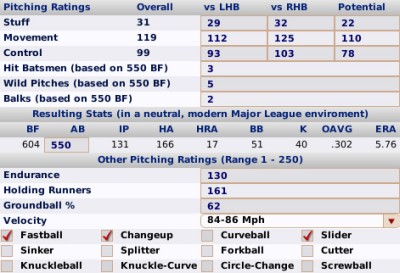
Most of the pitching ratings have slots for versus left-handed batters, versus right-handed batters, and potential. The standard ratings you see on the Player Profile are an average of the player's ratings against left and right. Most of the pitching ratings are pretty self-explanatory, if you understand the
Baseball Ratings model. The few items in here that need further explanation are below:
| Option | Description |
| Hit Batsmen (based on 550 BF) |
The number of batters the pitcher is expected to hit, per 550 batters faced. Note that this is NOT on a 1-250 scale! |
| Wild Pitches (based on 550 BF) |
The number of wild pitches the pitcher is expected to throw, per 550 batters faced. Note that this is NOT on a 1-250 scale! |
| Balks (based on 550 BF) |
The number of times the pitcher is expected to balk, per 550 batters faced. Note that this is NOT on a 1-250 scale! |
| Resulting Stats |
This section has no values to change other than the at-bats, but it simply tells you how a player with the ratings you have entered is expected to perform in a neutral, modern Major League environment. So, in the image above, you can see that this player is expected to have an ERA of 5.76 in a Major League environment. Not so great, but it might be fine if you expect him to be a minor league player. |
| Pitch Checkboxes |
Check boxes to add pitches to your pitcher's arsenal. A pitcher's combination of pitches and their varying skill levels are built into the Stuff/Movement/Control model. |
Defensive Ratings Editor
The Defensive Ratings section on the top right allows you to set the player's defensive and position ratings. Remember to hit Enter after editing any text fields! Unless otherwise noted, ratings are on a 1-250 scale, where 1-200 represents the normal range of skill. These values are then converted to whatever rating scale you use in game. For example, a 200 will become an 80 on a 20-80 scale, or a 100 on a 1-100 scale. Ratings of 201-250 are considered "beyond the norm," and will either result in a maximum rating, or a rating of
above the maximum, if you have set the
Show Ratings>Max option to "Yes" in the
Global Setup page. (The default is "No").

Most of the defensive ratings are pretty self-explanatory, if you understand the
Baseball Ratings model. The few items in here that need further explanation are below:
| Option | Description |
| Position Experience Chart |
The different position ratings are on a 1-200 scale for the amount of experience the player has at that position. This allows you to set the overall position rating for a player at each position. The right column shows you what the position rating will be based on the amount of experience you have given them. These will change based on the defensive ratings above, too. For example, a third baseman with 100 experience and a 250 Infield Range will have a much better overall position rating than the same third baseman with a 10 Infield Range. |



















